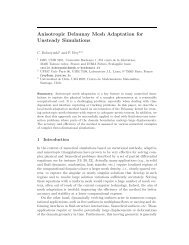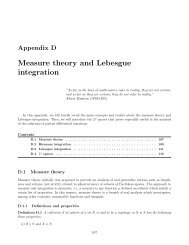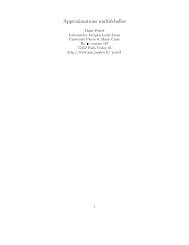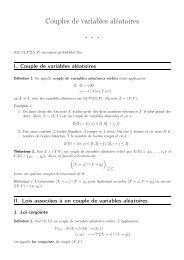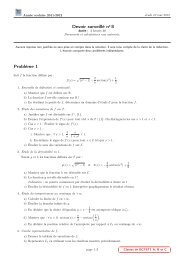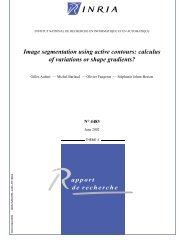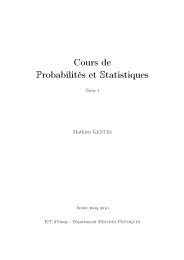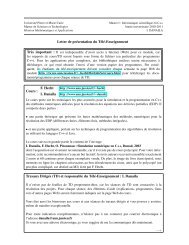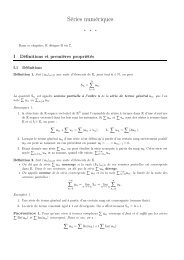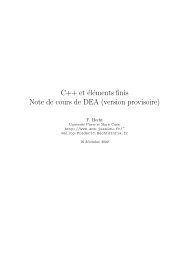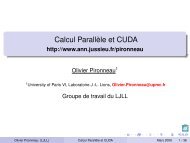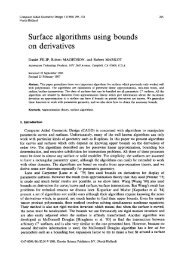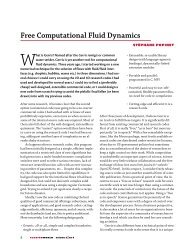Hermite Interpolating Polynomials and Gauss-Legendre Quadrature
Hermite Interpolating Polynomials and Gauss-Legendre Quadrature
Hermite Interpolating Polynomials and Gauss-Legendre Quadrature
Create successful ePaper yourself
Turn your PDF publications into a flip-book with our unique Google optimized e-Paper software.
Integrating L(x) over the interval a ≤ x ≤ b yields the trapazoidal rule<br />
b<br />
a<br />
f(x) dx ≈<br />
b<br />
b<br />
f(a) (x − b) dx/(a − b) + f(b) (x − a) dx/(b − a)<br />
a<br />
a<br />
= f(a) ·<br />
b − a<br />
2<br />
+ f(b) · b − a<br />
2 ,<br />
Here Q = 2, the quadrature points are x1 = a, x2 = b, <strong>and</strong> the quadrature weights are<br />
w1 = w2 = b−a<br />
2 .<br />
Error Analysis for Lagrange <strong>Quadrature</strong>.<br />
If L(x) is the polynomial of degree Q − 1 which interpolates f(x) at {xi} Q<br />
i=1 <strong>and</strong> if<br />
f ∈ C Q [a, b], then it can be shown that the pointwise approximation error is given by<br />
where<br />
f(x) − L(x) = 1 d<br />
Q!<br />
Qf dxQ (ξx) π(x), for some ξx ∈ (a, b), (7)<br />
Q<br />
π(x) ≡ (x − xk) = (x − x1)(x − x2) · · · (x − xQ). (8)<br />
k=1<br />
By integrating (7) we obtain the quadrature error bounds<br />
<br />
<br />
<br />
b<br />
Q<br />
<br />
<br />
<br />
f(x)dx − f(xq)wq<br />
<br />
<br />
a<br />
q=0 <br />
=<br />
<br />
1 <br />
b<br />
d<br />
<br />
Q! a<br />
Qf dxQ (ξx)<br />
≤<br />
<br />
<br />
<br />
π(x) dx<br />
<br />
1<br />
Q! max<br />
<br />
<br />
d<br />
<br />
a≤ξ≤b <br />
Q ≤<br />
<br />
f b<br />
<br />
(ξ) |π(x)| dx<br />
dxQ a<br />
(9)<br />
1<br />
Q! max<br />
<br />
<br />
d<br />
<br />
a≤ξ≤b <br />
Q <br />
f <br />
<br />
(ξ) <br />
dxQ max<br />
a≤x≤b |π(x)|<br />
b<br />
dx<br />
a<br />
≤ const (b − a) Q+1 . (10)<br />
Defining the interval length h = b − a, we obtain O(h Q+1 ) accuracy. The quadrature rule is<br />
exact (i.e., there is no quadrature error) for all polynomials of degree ≤ Q − 1 because the<br />
Qth derivative of these polynomials vanishes.<br />
Continuation of Example 1: For the trapazoidal rule, Q = 2, so the method is exact for<br />
polynomials of degree ≤ 1 <strong>and</strong> the accuracy is O(h 3 ) provided the function being integrated<br />
is twice continuously differentiable.<br />
Exercise 1. Derive Simpson’s rule, which is based on interpolation at points a, (a + b)/2,<br />
<strong>and</strong> b, <strong>and</strong> show that the accuracy is O(h 4 ), where h = b − a.<br />
<strong>Hermite</strong> Interpolation.<br />
Given a differentiable function f defined on discrete points {x1, . . . , xQ}, the <strong>Hermite</strong><br />
interpolating polynomial is the unique polynomial H of degree 2Q − 1 that interpolates f<br />
<strong>and</strong> its derivative,<br />
H(xi) = f(xi),<br />
dH<br />
dx (xi) = df<br />
dx (xi), i = 1, . . . , Q. (11)<br />
2



